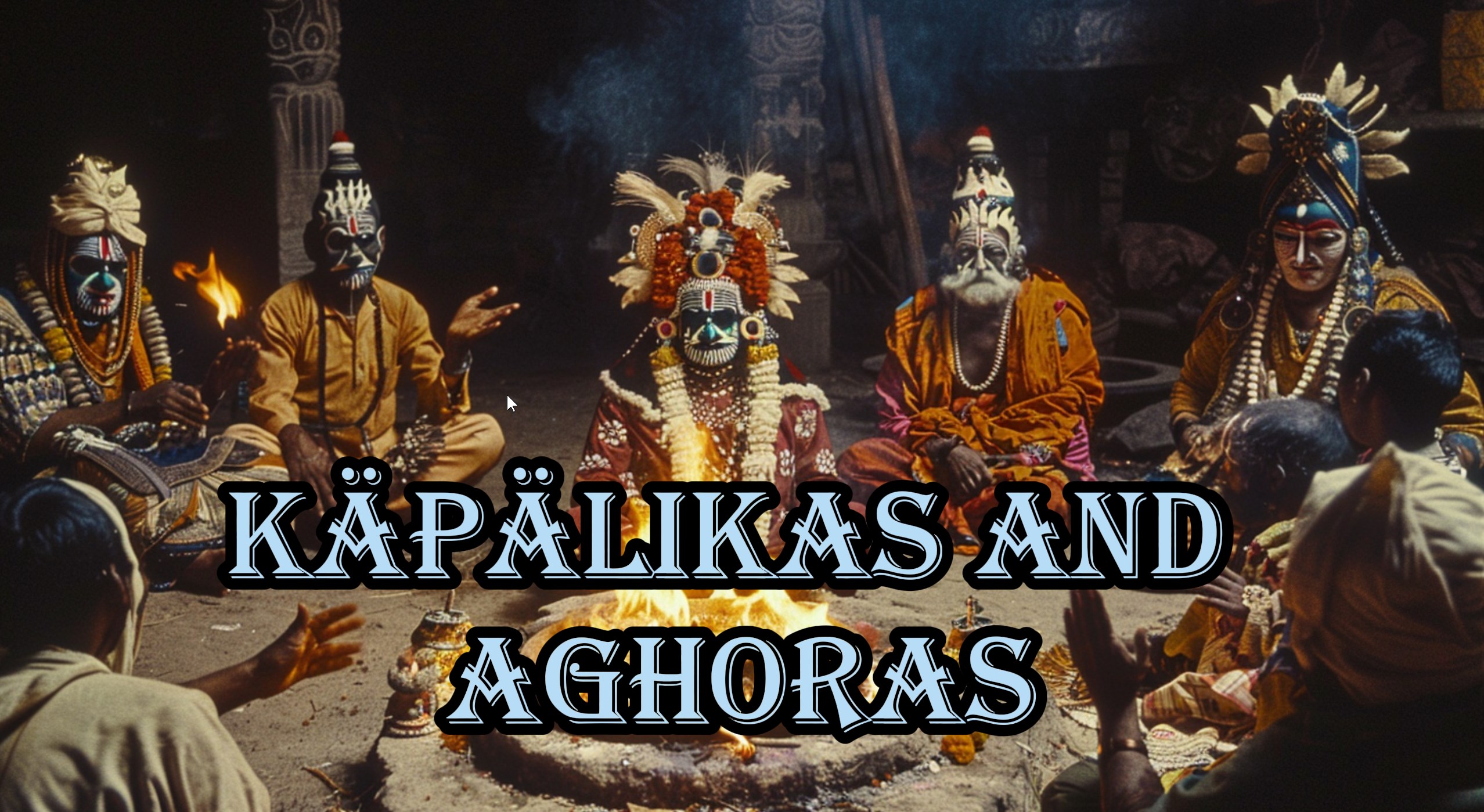Käpälikas and Aghoras One fine day the gods were sitting in heaven quaffing Soma. As it so happened, Brahma, the Creator, began to boast about the wonderful job he was doing. Siva disagreed, there were words, and punches, and then Siva got really cross and chopped off one of Brahmä’s heads with a fingernail. This left Brahmå with four heads and a pain in his neck, while Siva had to do penance to make up for the deed. He had to carry the skull of Brahmä, or perhaps only a bowl made of that skull, and make a living by begging for alms for twelve years. It didn’t make Brahmä very happy, as he never got his fifth head back, but it started Siva on a career as the divine skull carrier, This myth is at the roots of one of the earliest recorded Tantric systems.
The Kapalikas seem to have been well known by the sixth century and their cult flourished till the 13th or 14th century. Of course, in the beginning nobody thought of any activity as ‘Tantric’. The concept hadn’t been invented yet. Each Käpälika (female form: Käpälini) made a living by carrying a skull bowl, preferably made of the cranium of a Brahmin. It served to collect alms, food, or share drink, which often (and preferably) happened to be alcoholic. The Käpälikas were pioneers. Before the advent of the infamous Kaula tradition they were already exploring the limits of Hindu religion and often transgressed the social and ethical taboos.
As a result, few of their contcmporarics had a kind word for them. Nor did anybody bother to record (or copy) their scripture. Not a single text composed by a Käpälika has survived. What we know, or believe to know about them, comes from the writings of unfriendly outsiders. You can find a good synopsis of such material in Mircea Eliade’s Yoga (1960). Sadly, Eliade presents his material as if it were genuine evidence, not slander, and hardly hints that things may have been otherwise. To summarise those fables, the Kapalikas worshipped Siva in his terrible form as Mahakäla, meaning Great Time or Great Devourer, as it is time which devours everything. They considered the killing of animals and humans ‘heroic’, wore ornaments of human bone, practised human sacrifice (by throat slashing for Mahä Bhairava (the Great Terrible One, a form of Siva), and generally worshipped on cremation places. This took the form of drunken orgies involving public coitus and cannibalism, with crazed worshippers feeding on charred corpse-flesh. For sexual rites, prostitutes were highly esteemed and generally assumed the role of the goddess. They considered incest a sacred act and twice a year, in spring and autumn, they assembled for group-sex orgies to which a number of other religious and philosophical groups were admitted. So much for the negative, and highly questionable, reputation of the cult. An entirely different picture emerges from the researches of David ‘Lorenzen (in White 2000). In his essay, Lorenzen offers a short satirical play (Mattavilasa), allegedly composed by Mahendra Varman, a south Indian king who reigned from 600-630 CE.
The story revolves about a kapälika and his beautiful companion. The former, completely drunk and tottering, loses his skull-cup and accuses a passing Buddhist of having stolen the item. The two quarrel, then a Pä’upata ascetic mediates, and finally a madman turns up who had abducted the bowl in the first place. Fine amusement for better society and as fresh and entertaining today as it was during its composition (please read it, will you?). Anyway, what concerns us here is the way the Käpålikas are described. To begin with, the couple are parodied, but they remain sympathetic. There is not a single hint at human sacrifice, group-sex, or cannibalism. The Käpälika is drunk and certainly blasphemes, when he identifies the drinking stall with the Vedic altar, but apart from this he is not stupid, evil, or threatening.
He simply drinks, eats meat, and enjoys lovemaking. Even more interesting is his female companion Devasomä. As the daughter of a barber, she comes from a very low class (contact with hair is polluting). The two share alms, meat, and drink from the same skull-bowl. He addresses her as ‘my beloved’ while she calls him ‘lord’, but apart from that, their behaviour is by no means typical for Hindu couples. Devasomä is not an inferior. She says what she likes, speaks with outsiders without any sense of shame, looks after her drunken companion, and even fights with the Buddhist after her mate has collapsed. In one scene they both go happily mad and dance around, drumming on their cheeks, thereby copying the famous cheek- drumming of Siva and Käli. It comes as no surprise that she is oath- bound (an initiate) and a female devotee’. As she is strikingly beautiful, both the Buddhist and the Pasupata ascetic (unsuccessfully) lust after her, What makes this episode so interesting is that we encounter a proto- Tantric couple which lives pretty much as equals.
There have been too many scholars (usually Western and male) who proposed that women had little say in Tantra, apart from being worshipped and ‘used’ for ritual reasons. Devasomä does not fit this theory at all. More so, as the play is from the early seventh century, it predates most surviving Tantric literature, and gives good evidence that spiritual women of the time did not automatically assume the ‘little housewife’ role expected by Hindu orthodoxy. What else do we know about the Käpälikas? Lorenzen gives a few points worth considering. The Käpalikas undertook a Great Vow (mahavrata), specifying that the adept must beg, drink, and feed from the skull bowl. The cult had a doctrine (nowadays lost) called Soma- Siddhänta, the Doctrine of Soma. Unlike the Vedic Soma, the Käpålikas identified Soma as the union of Siva and Urnå (Parvati). Here, Siva is the sound Sa plus Umä yields Soma. It may be an early identification of the elixir of immortality, the divine drug of the Vedic seers, with the fluids generated by lovemaking. The Käpälikas were not always dangerous nutters dwelling at the fringes of society. One account mentions a vipra called Sorni-Bhagaraka who was an expert in Soma-Siddhänta and happened to be the abbot of a Siva temple. He walked covered in ashes, equipped with a club-staff, a skull, a rotation drum (damaru), a two- faced (thc mrdanga), and a (thigh bone) trumpet, plus six insignia.
These are given in another source, they consist of two sorts of earrings, a necklace, a jewelled crest, ashes, and a sacred thread. If we follow a hint in the Mattavilåsa the ‘sacred thread’ may have been snakeskin. Eliade proposes that the Aghori or Aghorapanthi developed out of the Käpälikas. Aghora means ‘not terrifying’ (or should that be ‘not terrified’) and is usually used to denote a group of friendly goddesses, that is. those who seem nice to the ignorant. Again we encounter a lot of vicious rumours. The Aghori were associated with the same sorts of fun activities as the Käpälikas, with an emphasis on eating forbidden things. Allegedly they ate all sorts of polluting things, including any form of meat (except, for some inexplicable reason, horse) to destroy their basic social conditioning and to make the devotees realise that good and bad, clean and polluted, and so on, are mere categories of thought. They did not believe in class, saw the function of parents as a coincidence, and respected only the guru and Siva, plus some goddesses such as Sitalä, Parnagiri, and Käli. Unlike the Käpälikas, they devoted themselves to abolute chastity. How true is this account? As before, Eliade did not bother to question his sources. He was so keen on discovering head- hunting religions in Tantra that he took any odd rumour for gospel. Including tales of cremation place cannibalism practised to the end of the 19th century under British rule,

